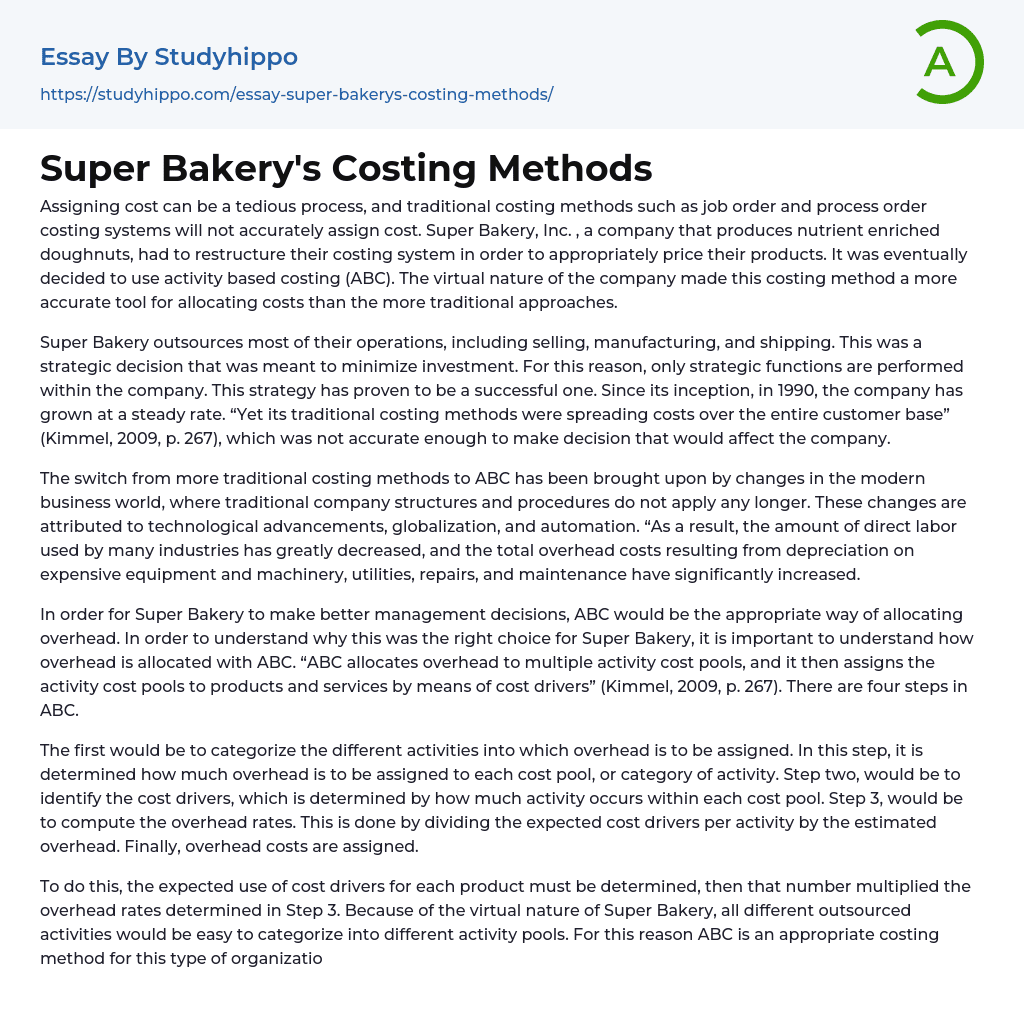Assigning cost can be a tedious process, and traditional costing methods such as job order and process order costing systems will not accurately assign cost. Super Bakery, Inc. , a company that produces nutrient enriched doughnuts, had to restructure their costing system in order to appropriately price their products. It was eventually decided to use activity based costing (ABC). The virtual nature of the company made this costing method a more accurate tool for allocating costs than the more traditional approaches.
Super Bakery outsources most of their operations, including selling, manufacturing, and shipping. This was a strategic decision that was meant to minimize investment. For this reason, only strategic functions are performed within the company. This strategy has proven to be a successful one. Since its inception, in 1990, the company has grown at a steady rate. “Yet
...its traditional costing methods were spreading costs over the entire customer base” (Kimmel, 2009, p. 267), which was not accurate enough to make decision that would affect the company.
The switch from more traditional costing methods to ABC has been brought upon by changes in the modern business world, where traditional company structures and procedures do not apply any longer. These changes are attributed to technological advancements, globalization, and automation. “As a result, the amount of direct labor used by many industries has greatly decreased, and the total overhead costs resulting from depreciation on expensive equipment and machinery, utilities, repairs, and maintenance have significantly increased.
In order for Super Bakery to make better management decisions, ABC would be the appropriate way of allocating overhead. In order to understand why this was th
right choice for Super Bakery, it is important to understand how overhead is allocated with ABC. “ABC allocates overhead to multiple activity cost pools, and it then assigns the activity cost pools to products and services by means of cost drivers” (Kimmel, 2009, p. 267). There are four steps in ABC.
The first would be to categorize the different activities into which overhead is to be assigned. In this step, it is determined how much overhead is to be assigned to each cost pool, or category of activity. Step two, would be to identify the cost drivers, which is determined by how much activity occurs within each cost pool. Step 3, would be to compute the overhead rates. This is done by dividing the expected cost drivers per activity by the estimated overhead. Finally, overhead costs are assigned.
To do this, the expected use of cost drivers for each product must be determined, then that number multiplied the overhead rates determined in Step 3. Because of the virtual nature of Super Bakery, all different outsourced activities would be easy to categorize into different activity pools. For this reason ABC is an appropriate costing method for this type of organization. Job order costing and process order costing take a more general approach to allocating costs, which used only one single estimated overhead rate for the year.
This was a process that Super Bakery previously used. In job order costing, direct labor cost was the primary activity, whereas machine hours were the primary activity in process order costing. Even though companies still exist where direct labor and machine hours are still the primary activity,
in which either costing methods would be appropriate, more modern company structures find that ABC is more appropriate because there are many other activities that factor into the company’s overhead.
With ABC, Super Bakery could more accurately assign overhead costs to their different products, and because of this they can better strategize. It also allows them to have better control of their overhead costs by being able to trace them to the different activities. The most important benefit of ABC is the ability to make better management decisions, such as pricing, continuation, or elimination of a product line. Better management decisions are all made in an effort to increase profitability levels, which is the bottom line of most companies.
- Chief Executive Officer essays
- Convenience Store essays
- Firm essays
- Training And Development essays
- Unilever essays
- Variable Cost essays
- Virgin Group essays
- Bargaining essays
- Entity essays
- Pest analysis essays
- Child essays
- Childcare essays
- Child labor essays
- Doll essays
- Academia essays
- Higher Education essays
- Language Learning essays
- Studying Business essays
- Education System essays
- Study essays
- First Day of School essays
- Scholarship essays
- Pedagogy essays
- Curriculum essays
- Coursework essays
- Studying Abroad essays
- Philosophy of Education essays
- Purpose of Education essays
- Brainstorming essays
- Educational Goals essays
- Importance Of College Education essays
- Brown V Board of Education essays
- The Importance Of Higher Education essays
- Online Education Vs Traditional Education essays
- Academic And Career Goals essays
- Academic Integrity essays
- Brown Vs Board Of Education essays
- Distance learning essays
- Technology in Education essays
- Vocabulary essays
- Writing Experience essays
- Importance of Education essays
- Early Childhood Education essays
- Academic Degree essays
- Academic Dishonesty essays
- School Uniform essays
- Academic writing essays
- Cheating essays
- Bachelor's Degree essays
- MBA essays




